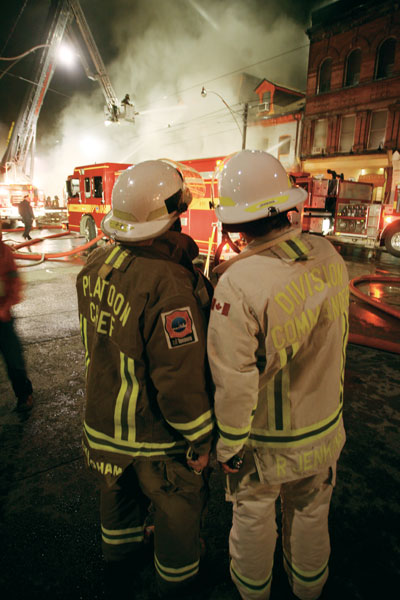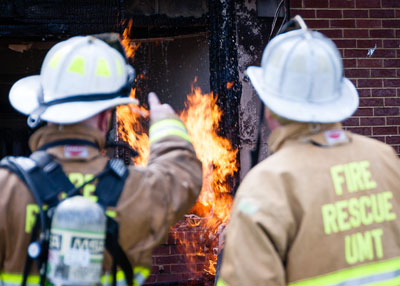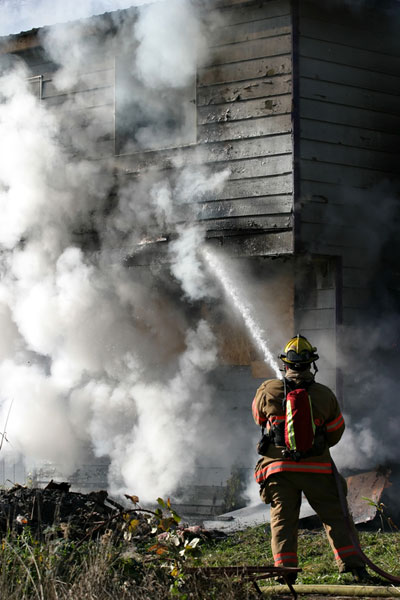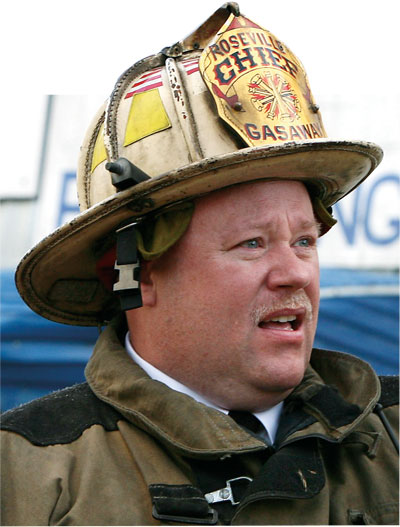
Features
Training
Situational awareness
Flawed situational awareness is one of the leading contributing factors in first-responder close calls and casualties.
April 22, 2013
By Richard Gasaway
Flawed situational awareness is one of the leading contributing factors in first-responder close calls and casualties. Complicating this problem is the fact that most first responders know very little about situational awareness, how they develop it, how they lose it and how to get it back once they have lost it.
 |
|
| Situational awareness is the ability of first responders to capture cues and clues from what is happening around them, then being able to put those clues and cues together to mean something, and predicting future events as a result of what has been captured and the meaning given to it. Many first responders struggle to explain what situational awareness is, how situational awareness is lost and what can be done to keep it intact. Photo by John Riddell
|
Basic first-responder training programs – for that matter, most officer training programs – do not teach situational awareness (SA). The programs that do address SA typically dedicate only a small amount of time to it, and most instructors are underprepared to speak to the complexities of the topic.
The situational awareness-related issues cited in casualty reports often include inadequate initial and ongoing size-ups, failure to continuously evaluate risks versus benefits during the entire operation, ineffective communication of incident conditions, and failure to recognize hazards.
When asked, many first responders struggle to explain what it means to have SA. Even worse, many responders struggle to explain how SA is lost and what can be done to keep it intact. In general, there is a lack of awareness . . . about awareness. How ironic.
Let’s start by discussing what SA is. After that, you’ll be in a better position to understand how situational awareness can be established, maintained, impacted, lost, and regained. I have heard several people offer simplistic definitions of situational awareness, which in some ways, capture the essence of the concept, yet do not do it justice. For example, I have heard SA described as paying attention, or where perception and reality meet. I can’t argue with those definitions, but what do they really mean? To help you understand situational awareness in a meaningful way, I turn to the work of Dr. Mica Endsley, the founder and president of SA Technologies (www.satechnologies.com).
Endsley has written more than 200 academic articles and several textbooks on issues related to situational awareness. Endsley defines situational awareness as a perception of elements in the environment within a volume of time and space, the comprehension of their meaning, and the projection of their status into the near future.
Situational awareness the ability of first responders to capture cues and clues (think of gathering up jigsaw puzzle pieces) from what is happening around them, then being able to put those clues and cues together to mean something (think of assembling some of the puzzle pieces to start forming a picture), and being able to predict future events as a result of what has been captured and the meaning given to it (think of looking at a partially completed jigsaw puzzle and making predictions about what the completed picture will look like).
Endsley’s research discovered that there are three levels of situation awareness. Level 1 is the perception phase – responders capture the cues and clues. Level 2 is the comprehension phase – responders put those cues and clues together to mean something. Level 3 is the projection phase – responders predict future events based on the picture formed in levels 1 and 2.
It is important to understand these steps; for example, failing to capture the right cues and clues will impact your ability to grasp what is happening and this, in turn, will impact your ability to predict what is going to happen next. Chances are pretty good that you have read an after-action report or watched a fire scene video in which something went wrong and said to yourself, “How could they not see this coming?” or perhaps you thought to yourself, “That could never happen to me.”
First of all, it is easy to read casualty reports or watch incident videos and become angry because what you see coming may appear to be obvious. Well, it wasn’t obvious to the responders operating at the incident at which something was about to go wrong. Keep in mind that no responders ever go to an incident thinking, “I’m going to lose my situational awareness on this call, make some bad decisions, and jeopardize my safety and the safety of other firefighters.” Yet it happens – a lot!
Most of the time the responders don’t see the problem coming until it’s too late. Maybe at the moment when the tragedy occurred they were doing the same thing, the same way they had done it for years. And because they had never experienced even so much as a minor close-call event, they didn’t see anything wrong with what they were doing. Maybe the responders thought they had good situational awareness. Then, it happened . . . a catastrophic casualty. The loss of situational awareness can afflict any first responder and impact decision making, and there may be no warning signs at all.
Issues relating to flawed SA and its impact on decision making have been studied in a number of professions in which decisions are made in dynamic, fast-paced, ever-changing, high-risk environments. Extensive research has been done to understand SA among military battleground commanders, airline pilots (especially when something has gone wrong and the flight is in jeopardy), and surgical teams. From this research has come some very important lessons from which first responders can learn. These include:
- A responder with poor SA can still make a good decision, if only by luck.
- A decision made with good SA can still have a bad outcome.
- Maintaining SA requires a physical, mental and emotional commitment to paying attention.
- What to pay attention to is not always obvious.
- A first responder’s attention is drawn away by things that are loud, bright, moving, or in close proximity to the responder (moving toward him or her).
- Responders rarely realize they are losing their SA until it is too late.
- Responders (in fact, all humans) can remember only seven (+/- two) unrelated pieces of information. Stress may reduce that number to five.
Unfortunately, most first responders simply do not know what they need to know about SA, how it is developed, how it is maintained, how it is lost, or how to get it back once it is lost. That was the position I was in just seven years ago. Then, in 2004, I went back to school to earn a doctor of philosophy degree. In that journey, I was provided with a wonderful opportunity to conduct original research on first-responder SA and high-stress, high-consequence decision making. I was stunned to learn what I didn’t know about these topics after serving as a firefighter, company officer and fire chief for 25 years.
I was also frustrated and angry because no one had ever taught me these important lessons. I couldn’t understand how I didn’t know this stuff already. I had taken no less than a dozen strategy and tactics, incident command, and officer-development classes throughout my career. Yet here I was, seeing for the first time that some important lessons had evaded me. It was a sobering experience.
Barriers
The purpose of my research was to answer a very simple, yet perplexing, question. For many years I had read casualty reports and close-call reports. While doing so, I kept asking how responders could not have seen the problem coming? There seemed to be so many clues, signs, symptoms and indicators that the incident was going to end in a disaster. It was as if the responders were blind and, in some cases, deaf to the things happening around them.
 |
|
| Barriers to situational awareness include staffing, communications, physical and mental stress, workload management and others.
|
Early on, when I would come across these cases, I would find myself passing judgment on those operating at the incident. I found myself making up excuses for them – lack of training, lack of experience, lack of staffing, lack of equipment, incompetency, etc. It got so that I was pretty good at categorizing each incident into a convenient, easily justifiable category. But it still did not answer the question: How could they not see it coming?
So that was among the questions my research would seek to understand. In the process, I uncovered barriers to situational awareness.
Simply stated, a barrier is something that prevents the formation of SA, causes SA to erode or prevents eroded SA from re-forming once it has been lost. When I started on this journey, I had no idea how many barriers there would be. I thought there might be 15 or 20.
Boy, was I wrong. Twenty turned to 40, then 60, then 80, then 100. When I was finished, there were 116 barriers on the list. I was stunned.
With so many ways our SA could be impacted, how could we ever get it right? It was at that moment I had an epiphany: after 25 years in the fire service and with more than 20 years’ experience as a company officer and incident commander, I realized I had not been a good company officer and fire-ground commander – I had been a lucky company officer and fire-ground commander. When it came to understanding the barriers to situational awareness, I had been the incompetent one. It scared me.
Through an exhaustive search of the literature, coupled with interviews conducted with expert-level fire-ground commanders, I have amassed this extensive list of SA barriers. As I assembled this list, similar barriers were grouped together, resulting in 12 categories of SA barriers:
- Staffing;
- Communications;
- Data/information management;
- Physical and mental stress;
- Workload management;
- Attention management;
- Mission/goals;
- Mental models;
- Human factors;
- Command location;
- Command support;
- Team/crew performance.
Each of these categories contains a list of barriers. For example, in the staffing category, there are potential barriers to responder SA that can arise from understaffing, overstaffing, unpredictable staffing, quality of staffing, response-time delays, lack of experience, and inadequately trained personnel.
In the communications category, there are potential barriers to responder SA from issues with verbal and non-verbal communication, progress/update reports, misinterpreted words or phrases, an incomplete communications loop, missed radio communications, radio equipment problems, non-compatible radio equipment, use of multiple radio channels, too much radio traffic, and crews unwilling or unable to communicate by radio.
As you can see, the list of potential SA barriers is rather extensive. While there is not enough space to list and discuss each of them here, I will share the most important lessons I learned from my interviews with first responders about how their SA was impacted.
The decisions made by first responders impact the safety of fellow responders as well as the outcome of the event. But responders are human and, thus, are subject to limitations and errors. The fire ground is a dynamic, complex decision-making environment that is critically dependent on forming and maintaining strong SA.
There seem to be several identifiable factors that impact responder situational awareness.
- The first factor is incomplete size-ups and, more specifically, failing to read the smoke and fire conditions, failing to assess building construction and the deterioration of the component of construction, and failing to conduct a realistic assessment of savable lives (or what some might call completing a survivability profile).
- Second, responders are underestimating the speed at which the incident is progressing. This can cause a responder to get behind in the incident and apply strategies and tactics that are not appropriate because the incident has progressed beyond their plan.
- Third, responders are overestimating their own abilities as well as the abilities of their fellow crew members. This is happening for several reasons, including not having enough personnel assembled to get the job done, and the assemblage of personnel who lack the training or experience to be efficient and effective at the assignments they are given.
- Fourth, responders are stressed from a sense of obligation to be tactically aggressive. This pressure may come from the organization’s culture or from upset customers who have unrealistic expectations of what the fire department could or should be doing to mitigate their emergency. This can lead to pressure to perform heroically and cause responders to take excessive risks, despite a high level of awareness of the dangers present in the situation.
- Last, responders struggle because they are focused on the wrong things, or they try to split their attention among too many tasks. This is a big mistake. The human brain cannot multi-task when it comes to paying attention. Some responders think they’re good at multi-tasking when, in fact, they are not multi-tasking at all. They can give their attention to only one task at a time. Think of it this way: on your personal computer, open up an e-mail window and a word processing document. Now, multi-task by typing an e-mail and a sentence on the document at the same time. It can’t be done. You can go from one to the other and back but it simply is not possible to complete both tasks at the same time. The same is true for paying attention. You alternate your attention between tasks – back and forth – but you cannot multi-task. The brain cannot do it.
Best practices
The research I conducted identified an extensive list of best practices to help first responders develop and maintain situation awareness. Here are 10 of those best practices.
1. Responders must capture and process critical cues and clues to predict future events
As a responder conducts a size-up (e.g., at a residential dwelling fire) there are dozens, perhaps hundreds, of cues and clues that can indicate what is happening and help responders make accurate predictions about future events. Based on the findings in the literature and the input from experts who participated in my research, the most pertinent cues and clues at a residential dwelling fire may include:
An evaluation of smoke and fire conditions;
- Consideration of the construction and level of decomposition of the structure;
- The speed at which the incident is moving;
- A realistic assessment of savable lives in the IDLH environment.
2. Responders should set the strategy and tactics based on available resources
Staffing issues were significant factors that caused responders concern and potentially impacted their SA. The expert responders I interviewed recommended conducting continual assessments of the scene until sufficient staffing (e.g., based on quantity, quality, training and experience) arrives on the scene. The experts cautioned against setting a strategy and committing to tactics until the proper quantity and quality of personnel are
present to accomplish the tasks.
3. Responders should develop and maintain a big-picture focus of the incident scene
Repeatedly, the expert responders I interviewed noted that they were impacted when their attention was narrowed because they focused on one area of an incident scene, or on one task being performed. The experts recommended developing and maintaining a big-picture focus on the incident by developing meta-awareness, a conscious awareness of the larger incident scene and purposeful avoidance of narrowing attention to one task or one area of the scene.
4. The person in charge (i.e., incident commander) should not perform hands-on duties
The expert incident commanders I interviewed frequently noted that among the most insidious ways their awareness is impacted is when they performed hands-on fire-ground duties and, consequently, this caused them to overlook critical cues and clues and lose track of the speed at which the incident was changing. Expert commanders recommended displaying self-restraint by avoiding the temptation to be drawn into performing non-command tasks (i.e., pulling/advancing hose lines, setting fans or ladders, connecting hose to a fire hydrant, or serving as the pump operator).
5. Responders cannot listen to and comprehend multiple conversations simultaneously
The responders I interviewed described multiple scenarios during which their SA had been impacted because they missed important radio messages from commanders or other responders operating on the emergency scene. This was especially problematic when the radio messages were transmitted from crews operating in hazardous environments. Responders rightfully noted that it was almost impossible to listen to and comprehend simultaneous messages, be they from multiple radio channels or during face-to-face communications. The experts recommended giving priority attention to the radio messages of responders operating in hazardous environments. This may be facilitated by operating on a single operational channel or by assigning someone to monitor radio traffic of crews operating in hazardous environments.
6. The incident commander should be far enough back from the incident to see the big picture
The expert commanders I interviewed were split in their opinions on the best place to run command. Some said they preferred to be outside a vehicle, in the front yard or standing on the street where, they noted, they benefited from being able to use all of their senses to capture cues and clues on the scene. Other incident
commanders said they preferred to be located in a vehicle where they described the environment as calmly and free of distractions and interruptions as possible. The one universal recommendation from all the commanders, regardless of where their command location started, was that when the incident became complex or they were being overwhelmed, they preferred to be remotely located. Every commander interviewed said that under extremely stressful conditions, he or she had retreated to the sanctity of a vehicle (or other remote location). The commanders also stressed the importance of completing a thorough size-up including a 360 walk-around prior to assuming a position that is physically out of the action.
7. Responders should take steps to control distractions and interruptions
Responders spoke frequently about how distractions and interruptions impact their SA. Commanders of residential dwelling fires noted that police officers, occupants, neighbours, bystanders, utility company workers and other firefighters offering unsolicited advice were among the culprits that distracted their attention away from the big picture. Responders are also distracted by noises (e.g., sirens, air horns, engines, tools, screaming and yelling). The experts recommend a degree of self-discipline to stay on task, and a willingness to tell those wishing to speak face to face to refrain from interrupting the responder who is listening to radio traffic from personnel who may be operating in high-hazard environments. For incident commanders, the experts recommended being located out of sight of those who might distract their attention.
8. Responders (including commanders) should manage their span of control
The experts noted that it was easy to become overwhelmed if they had to perform too many command roles, process too much information, listen to multiple radio channels, and/or complete a size-up while focusing on the safety of the personnel deploying in the fire fight. The experts said that assigning subordinate command duties (e.g., safety, staging and operations) was essential to keep the incident commander from being overloaded. The experts spoke favourably of assigning a person to serve as an aide, noting the aide can free the incident commander’s mental capacity to concentrate on the most important aspects of the fire-ground operations. The experts also noted that the presence of a senior advisor to help the incident commander with the delegation of duties was very beneficial. The experts felt that the use of a unified command, where ranking officers from all agencies involved are physically located together, facilitated an efficient distribution of duties and a sharing of knowledge that enhances commander SA.
9. The incident commander must establish and maintain a strong command presence
The experts noted it was important to establish a strong command presence by displaying confidence and focused leadership at the incident scene. The experts also said that in order to accomplish this, it was essential to display emotional self-control (e.g., controlling excitement, frustration, anger, etc.), especially during the most stressful periods of an incident. The experts noted their behavior and demeanour oftentimes sets up the incident for success or failure because crews react based on the behaviour and demeanour of the commander.
 |
|
| Experts say the reduction in actual fires impacts the ability of responders to develop and maintain skills. This is why it is so important to conduct realistic training scenarios, which help responders develop the ability to make good decisions under stress.
|
The experts also noted that it was very important to control the action of crews, ensuring that personnel do not engage in independent goal setting (freelancing) and that commanders know where personnel are operating and what they are doing at all times. The experts also said it is very important to be clear, concise, articulate and confident when giving orders. Furthermore, they were strong advocates of the need to be consciously aware of the passage of time on the emergency scene, noting the commander may be the only one with access to a watch or clock to mark and keep track of time.
10. Responders should accelerate their expertise
The experts spoke openly about a general reduction in the number of residential dwelling fires over the past 20 years. The reduction in actual fires impacts the ability of responders to develop and maintain skills. The experts said this is why it is so important to conduct realistic training, noting that challenging real-life training scenarios help to develop responder skills and enhance a responder’s ability to make good decisions under stress. They strongly recommended the use of simulations, as well as using case studies and watching video clips of fire incidents, which are readily available on the Internet. They were also strong advocates of using close-call reports to accelerate learning based on the mistakes of others. They also spoke favourably of the valuable lessons that can be learned from line-of-duty death investigation reports. Performing post-incident evaluations after each emergency was another way the experts recommended to identify potential issues and to reinforce the application of best practices. Finally, the experts recommended that developing supervisors and incident commanders be paired with mentors who can provide coaching and feedback so the novice supervisor/commander can learn from mistakes, even if the outcome of the error was not a close-call or casualty incident.
In high-stress emergency settings, failing to capture critical incident cues and clues, failing to comprehend those cues and clues as meaningful, and failing to use that meaning to project future events, is the recipe for close-call and catastrophic events on the fire ground. The foundation for good decision making lies in the ability to develop and maintain strong situational awareness, so you can see the bad things coming in time to change the outcome.

|
|
Dr. Richard B. Gasaway joined the fire service in 1979 and has worked for six emergency services agencies including serving as a career fire chief for 20 years. Chief Gasaway’s doctoral research is focused on the neuroscience of decision making under stress and the barriers that impact situational awareness. Chief Gasaway has authored four books on the topic: Situational Awareness Volumes 1 & 2, Situational Awareness for Emergency Response, and Fireground Command Decision Making. He has also created three DVD series to improve first-responder safety: Mental Management of Emergencies: Improving situational awareness and decision making under stress, Fifty Ways to Kill a First Responder: Understanding 50 barriers that impact situational awareness, and Training for Failure: Why some first responder training must change. Contact Gasaway at rich@richgasaway.com and follow him on Twitter at @SAMatters
Print this page